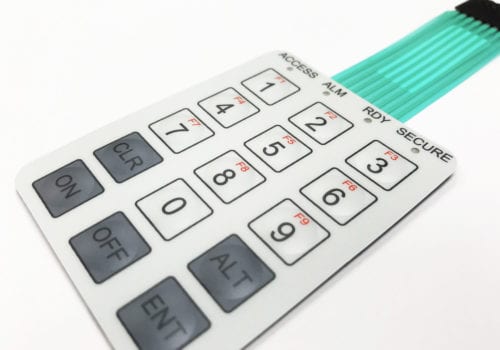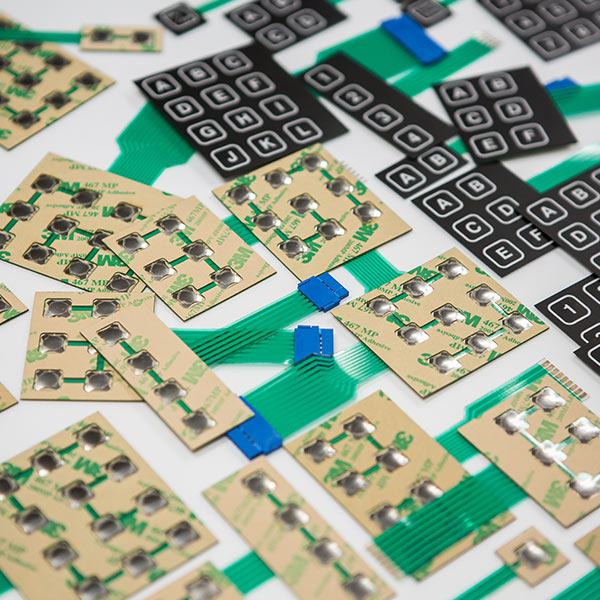Membrane Layer Switches Explained: A Comprehensive Overview to Their Benefits
Membrane switches over stand for a advanced and flexible solution for creating customer interfaces throughout a range of industries. As industries progressively seek efficient and dependable control user interfaces, recognizing the details advantages and applications of membrane changes becomes vital.
What Are Membrane Layer Buttons?

When pressure is related to the membrane layer switch, the layers make contact, completing an electrical circuit. This simple mechanism enables for a vast array of applications, from customer electronics to industrial machinery. Membrane layer buttons are often designed to be water-proof and immune to dirt and impurities, making them appropriate for settings where sturdiness is important.
Additionally, the versatility of the products utilized in membrane switches over helps with cutting-edge designs that can comply with numerous forms and measurements. This flexibility adds to their popularity in diverse fields, including medical gadgets, vehicle controls, and home devices. Overall, membrane switches represent a vital component in modern interface innovation, linking the void in between users and electronic systems.
Secret Benefits of Membrane Buttons
Among the myriad of individual interface alternatives readily available, membrane switches stick out for their one-of-a-kind combination of advantages. Among the main benefits is their small and lightweight layout, which permits assimilation into a vast array of gadgets without adding significant bulk. This is particularly beneficial in applications where area is restricted.
In addition, membrane layer changes offer sturdiness and resistance to ecological variables. They are typically constructed with materials that can stand up to dampness, dirt, and numerous chemicals, making them ideal for harsh problems. This resilience contributes to a much longer life expectancy compared to standard mechanical buttons.
An additional substantial benefit is the adaptability in customization. Membrane layer switches can be printed with various graphics, shades, and appearances, permitting for tailored designs that fulfill particular branding or useful demands. This adaptability includes the variety of layers and circuit options, supplying engineers with several arrangements.
Furthermore, the responsive feedback supplied by some membrane layer switches boosts user experience, making them much more instinctive to operate. The ease of cleansing and upkeep even more strengthens membrane layer switches as a functional selection in both customer and industrial applications. Generally, these vital advantages make them a favored option for many developers and manufacturers
Applications in Numerous Industries
Exactly how do membrane layer buttons locate their place throughout varied industries? Their adaptability and capability make them integral components in markets varying from medical care to consumer electronics. In medical devices, membrane switches are used for their convenience of cleansing and resistance to contamination, ensuring hygiene in atmospheres where sterility is essential.
In the consumer electronics visit homepage industry, these switches supply streamlined, user-friendly interfaces that enhance item aesthetics while preserving durability against wear and tear. Automotive applications gain from membrane switches over as well, where they are utilized in dashboards and control panels, using trustworthy efficiency in challenging problems.
In addition, industrial machinery uses membrane layer switches for control panels as a result of their toughness, ability to withstand rough atmospheres, and adjustable designs that deal with certain operational demands. The food market leverages membrane buttons for their simplicity of use and resistance to spills, ensuring operational performance in busy settings.
Ultimately, the versatility of membrane switches over across these varied applications highlights their important duty in contemporary innovation, enhancing customer interaction while fulfilling industry-specific requirements. Their proceeded evolution guarantees further assimilation into arising fields and ingenious products.
Layout and Personalization Options
The style and customization choices readily available for membrane buttons are essential for customizing user interfaces to fulfill certain user requirements and visual preferences. These buttons can be designed in different forms, sizes, and formats, permitting for seamless assimilation right into diverse applications. The versatility in layout implies that suppliers can create unique user interfaces that enhance use and preserve brand identity.
Customized textures, graphics, and colors can be applied to the surface area of the membrane layer button, giving a chance for branding and individual interaction. In addition, backlighting alternatives, such as LED lighting, can be incorporated to improve visibility in low-light conditions, therefore improving performance.
Useful components can additionally be tailored, consisting of responsive responses and actuation pressure, which can be adapted to match various customer interactions. The choice of materials, such as polyester or polycarbonate, permits variations in durability and environmental resistance, accommodating the details demands of various industries.
Inevitably, the substantial layout and customization capabilities of membrane buttons make it possible for firms to create aesthetically enticing and straightforward user interfaces, guaranteeing that their products fulfill both aesthetic and functional requirements effectively. Membrane Switches.
Considerations for Execution
Carrying out membrane layer changes calls for careful factor to consider of numerous elements to make certain optimal performance and customer experience. Factors such as exposure to wetness, severe temperature levels, and chemical substances can substantially influence the switch's efficiency and longevity.

Another essential element is the switch's style and design. Making certain that the responsive responses and actuation pressure straighten with user expectations improves functionality. Carrying out individual screening can give valuable understandings right into the Full Report optimum layout.
In addition, compatibility with digital parts have to be assessed. The switch's circuitry need to straighten with the total system style, making certain dependable signal transmission and minimizing disturbance.
In addition, manufacturing approaches and prices must be assessed. The choice in between personalized styles and conventional designs can influence both budget and lead time.
Last but not least, take into consideration upkeep and fixing. Membrane layer buttons might require specific cleaning and treatment treatments to keep their appearance and capability over time. By addressing these factors to consider, organizations can implement membrane layer switches that fulfill their operational needs while giving a positive customer experience.

Final Thought
In final thought, membrane layer changes stand for a versatile and sturdy control user interface ideal for a vast range of applications throughout several sectors. Membrane Switches. As technology continues to progress, the relevance of membrane buttons in modern devices continues to be significant, using both functionality and visual appeal.
Membrane changes stand for a flexible and advanced solution for creating individual interfaces across a selection of fields.Understanding the basic parts of modern electronic user interfaces, membrane layer switches are a kind of user interface gadget that are composed of flexible, slim layers of material. On the whole, membrane changes stand for a crucial component in modern-day individual interface technology, bridging the gap in between users and digital systems.
Among the myriad of individual interface choices offered, membrane switches stand out for their unique combination of benefits.The layout and modification choices offered for membrane switches are important for tailoring interfaces to fulfill certain individual needs his explanation and aesthetic choices.